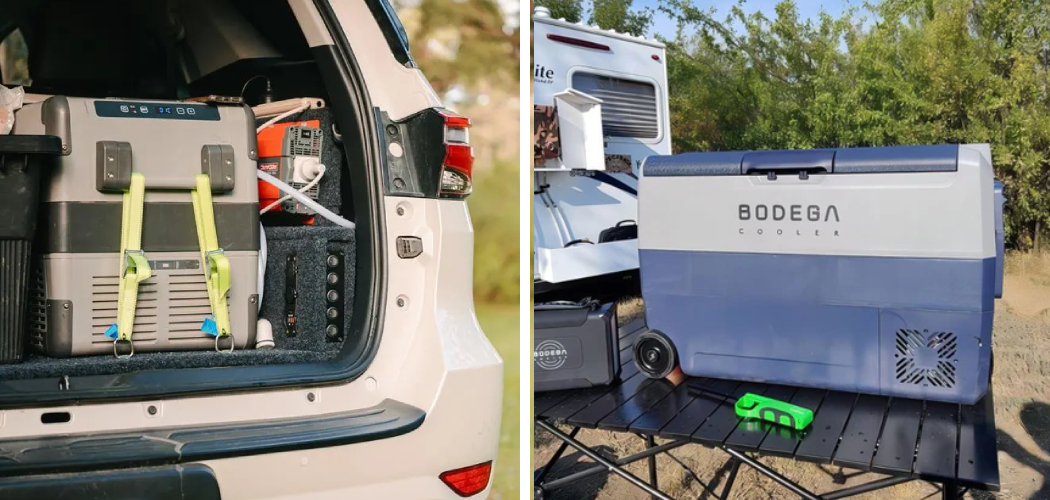A car fridge, also known as a portable refrigerator, is a compact cooling device that your vehicle’s battery can power. It is perfect for long road trips and outdoor activities where you need to keep your food and drinks cold. This guide will discuss how to run a car fridge and provide some tips on maintaining it.
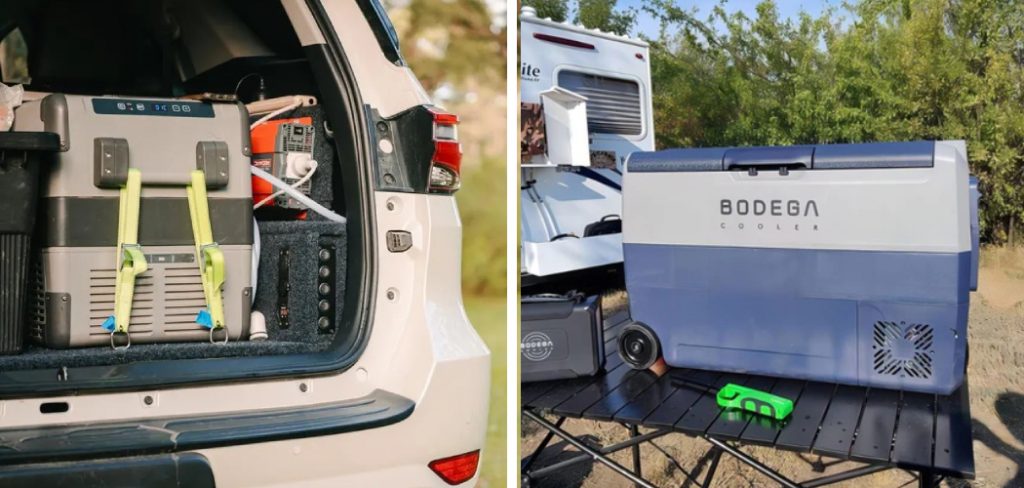
Necessary Items
To run a car fridge, you will need the following items:
- Car fridge
- Vehicle battery or power source
- Extension cord (if necessary)
- Cooler bag or ice packs (optional)
8 Things to Know Before You Start
1) Check the Voltage
Before using your car fridge, make sure to check its voltage requirements. Most fridges require 12V DC power, which is the standard for most vehicles. However, some fridges may require a higher or lower voltage, so it’s important to double-check before plugging it in.
2) Use a Dedicated Power Outlet
When running a car fridge, it’s best to use a dedicated power outlet specifically designed for this purpose. This will ensure that your fridge has a stable power supply and avoids overloading the vehicle’s electrical system.
3) Don’t Run Your Fridge Continuously
To conserve battery life, avoid running your car fridge continuously. Instead, turn it on when you need to chill or freeze your items and then turn it off when not in use. As a general rule, try not to run your fridge for more than 12 hours at a time.
4) Keep Your Vehicle Running
For optimal performance, it’s recommended to keep your vehicle running while the fridge is in use. This will help maintain a constant power supply and prevent draining your car battery. And even if your fridge has a low-voltage cut-off feature, it’s still best to keep the engine running.
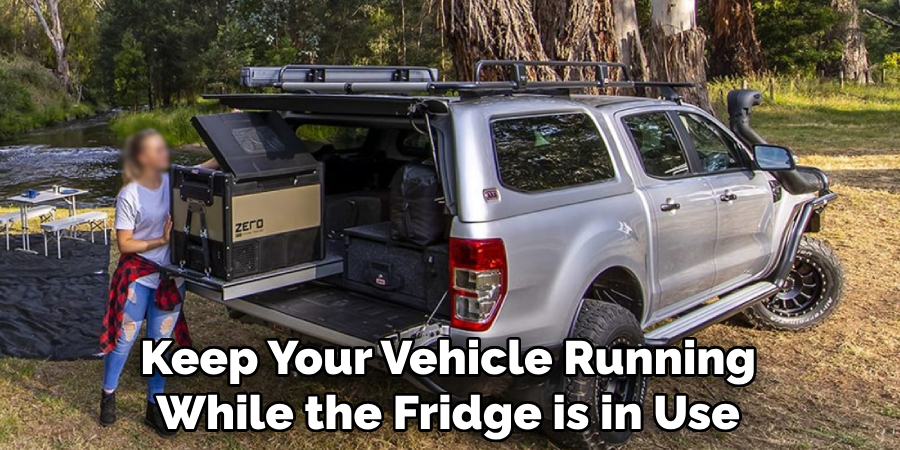
5) Avoid Overloading Your Fridge
It’s essential not to overload your car fridge with items as this can affect its cooling efficiency. Be mindful of its capacity and try to evenly distribute the items inside. Overcrowding can also cause the fridge door to not close properly, resulting in warm air entering and affecting the temperature.
6) Keep Your Fridge Level
To prevent leaks and maintain proper functionality, make sure to keep your car fridge level at all times. Uneven surfaces can cause the fridge to tilt, which can affect its cooling performance and potentially damage the compressor.
7) Regularly Clean and Defrost
Just like a regular fridge, it’s important to clean and defrost your car fridge regularly. Wipe down the interior with a mild soap solution and avoid using harsh chemicals that can damage the material. For defrosting, turn off the fridge and let it sit for a few hours or overnight before wiping away any moisture.
8) Be Mindful of the Temperature
Car fridges work best in moderate temperatures, so it’s important to keep your fridge out of direct sunlight or extreme heat. If possible, park your vehicle in a shaded area and use a cooler bag or ice packs for additional insulation.
Running a car fridge is relatively simple, but it’s crucial to follow these tips to ensure its proper functioning and longevity. With proper care and maintenance, your car fridge can be a valuable addition to your outdoor adventures or long road trips. Happy chilling! So, these are some tips on how to run a car fridge, along with necessary items and precautionary measures to follow. Remember to always check the manufacturer’s instructions for specific details on your car fridge model.
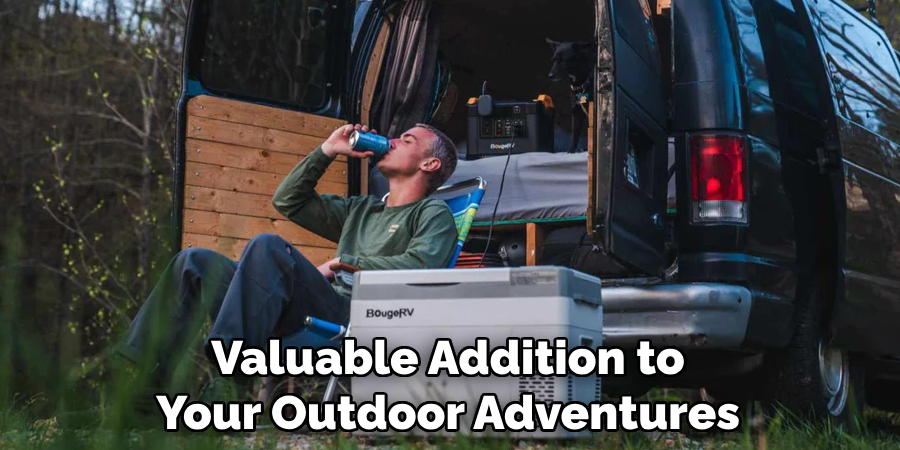
12 Steps on How to Run a Car Fridge
Step 1: Prepare Your Fridge
Before using your car fridge, it’s essential to make sure it is clean and empty. Wipe down the interior with a mild soap solution and let it air out for a few minutes. While doing this, you can also check for any damages or signs of wear and tear.
Step 2: Check Voltage Requirements
As mentioned earlier, it’s crucial to check the voltage requirements of your car fridge before plugging it in. This will prevent any potential electrical problems and ensure proper functioning. So, make sure your fridge is compatible with your vehicle’s power source.
Step 3: Place Your Fridge on a Level Surface
Find a flat and stable surface to place your car fridge. This will ensure proper cooling performance and prevent any damages or leaks caused by uneven surfaces. But if you’re using your fridge in a moving vehicle, secure it with straps or bungee cords to keep it from sliding around.
Step 4: Connect the Power Source
Using a dedicated power outlet, connect your car fridge’s power cord to your vehicle’s battery. If necessary, use an extension cord with the appropriate voltage rating. Double-check all connections to ensure a secure and stable power supply.

Step 5: Turn On Your Fridge
Once everything is connected, turn on your fridge and adjust the temperature settings according to your needs. It may take some time for the fridge to reach its desired temperature, so be patient. And remember to keep an eye on the battery level of your vehicle while it’s running.
Step 6: Organize Your Items
When placing items inside your car fridge, avoid overcrowding and try to distribute the weight evenly. This will help maintain the fridge’s cooling efficiency and prevent damage to its internal components. Also, make sure the door can close properly without any obstructions.
Step 7: Keep an Eye on Temperature Changes
While using your car fridge, it’s essential to monitor any changes in temperature. If the fridge is not maintaining its desired temperature, check for potential issues, such as an open door or a damaged seal. Also, keep an eye on the weather and adjust accordingly.
Step 8: Turn Off Your Fridge When Not In Use
To conserve battery life and ensure the longevity of your car fridge, remember to turn it off when not in use. This will also prevent any potential issues that may arise from running the fridge continuously.
Step 9: Keep Your Vehicle Running
As mentioned earlier, it’s best to keep your vehicle running while using your car fridge. This will help maintain a constant power supply and prevent draining your battery. And if you need to turn off the engine for any reason, remember to also turn off the fridge.
Step 10: Clean and Defrost Regularly
To maintain proper functioning, it’s important to clean and defrost your car fridge regularly. Wipe down the interior with a mild soap solution and turn off the fridge for a few hours or overnight for defrosting. This will prevent any build-up of moisture and keep your fridge clean.

Step 11: Be Mindful of the Temperature
Avoid placing your car fridge in direct sunlight or extreme heat, as this can affect its cooling performance. If possible, park your vehicle in a shaded area and use additional insulation methods such as cooler bags or ice packs.
Step 12: Store Your Fridge Properly
When not in use, it’s important to properly store your car fridge to prevent any damage. Make sure it is clean and dry before storing it in a secure place, preferably in its original packaging. This will also make it easier for the next time you need to use it.
Properly running a car fridge is essential for an enjoyable outdoor adventure or road trip. By following these tips and steps, you can ensure the longevity and efficient functioning of your car fridge. Remember to always check the manufacturer’s instructions for specific details on your model, and happy chilling! So, now that you know how to run a car fridge, go out and enjoy all the convenience and benefits it has to offer.
8 Things to Avoid While Running a Car Fridge
Even with proper care and maintenance, there are some things you should avoid while running a car fridge to prevent any potential issues or damages. Here are eight things to keep in mind when using your car fridge:
1) Overcrowding
Avoid overfilling your car fridge, as this can affect its cooling efficiency and cause damage to internal components. If necessary, use additional cooler bags or ice packs for extra storage.
2) Rough Handling
Be mindful when handling your car fridge, as rough movements can cause damage to its internal components. Secure it with straps or bungee cords while in a moving vehicle and avoid any sudden impacts or jolts.
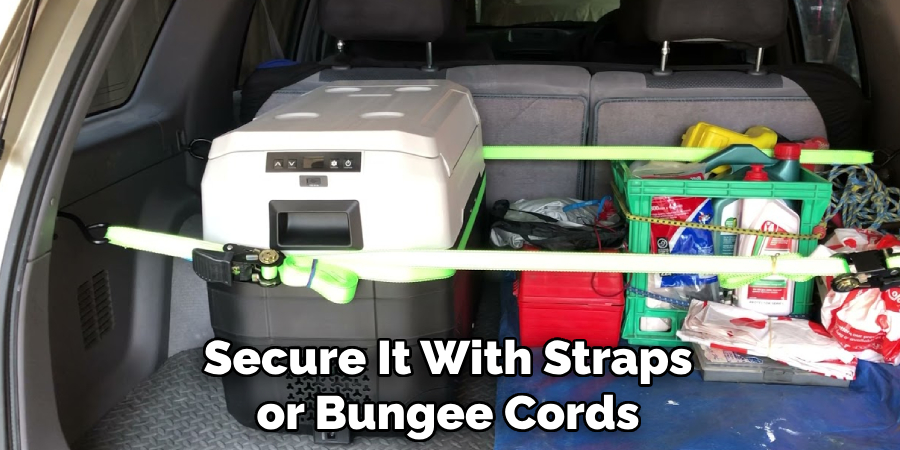
3) Excessive Temperature Changes
Extreme temperature changes, such as going from a hot car to a cold room, can cause condensation and moisture to build up inside the fridge. This can lead to potential issues and damages if not addressed.
4) Running Without Proper Ventilation
Make sure your car fridge has proper ventilation while running. Blocking air vents or placing it in an enclosed space can affect their cooling performance and potentially damage the fridge. So, avoid placing objects on top or around the fridge.
5) Running With an Empty Fridge
Running your car fridge with no items inside can cause it to work harder than necessary and potentially damage its internal components. So, make sure to fill it up with items when in use. So, make sure to fill it up with items when in use.
6) Using Sharp Objects
Avoid using sharp objects or utensils inside your car fridge, as they can puncture the walls and cause leaks. Use plastic containers or bags for storage instead of metal cans or bottles. But if you do need to store sharp objects, make sure they are properly secured and won’t cause any damage.
7) Placing in Direct Sunlight
Direct sunlight or extreme heat can affect the cooling performance of your car fridge. So, avoid placing it in an area where it’s exposed to direct sunlight for long periods. If possible, park your vehicle in a shaded area or use additional insulation methods.
8) Not Properly Cleaning and Defrosting
Regular cleaning and defrosting are essential for the proper functioning of your car fridge. Avoid neglecting these tasks as it can lead to potential issues such as mold growth or damage to internal components. Make sure to follow the manufacturer’s instructions for specific details on cleaning and defrosting your model. So, with these tips in mind, you can ensure the efficient and safe operation of your car fridge while on the road. So, go out and enjoy all the convenience and benefits a car fridge has to offer without any worries!

8 Additional Tips for Running a Car Fridge
In addition to the do’s and don’ts of running a car fridge, here are some extra tips to keep in mind for an optimal experience:
1) Plan Ahead
Before your trip, plan out what items you need to bring and how much space they will take up in your car fridge. This will help avoid overpacking and ensure you have enough storage space for everything.
2) Use a Fridge Slide
Investing in a fridge slide can make accessing your car fridge much easier, especially if it’s placed in the back of your vehicle. This will also prevent any damage to the fridge from constantly moving it in and out of the vehicle.
3) Keep Food at Safe Temperatures
Make sure to keep perishable food items at safe temperatures while on the road. Use a thermometer to monitor the temperature inside your car fridge and adjust accordingly. As a general rule, keep food below 40°F (4°C) to prevent bacterial growth.
4) Keep Your Car Battery Charged
Running a car fridge requires power from your vehicle’s battery. So, make sure to drive and start your vehicle regularly to avoid draining your battery. However, if needed, you can also invest in a separate battery for your car fridge.
5) Use a Fridge Cover
A fridge cover can provide additional insulation and protection for your car fridge. It can also help maintain consistent temperatures inside the fridge while on the road. This is especially useful for longer trips or when storing the fridge in extreme weather conditions.
6) Keep the Lid Closed
Avoid constantly opening and closing your car fridge, as this can affect its cooling performance and cause it to work harder than necessary. Make sure to only open it when needed and close it tightly afterward.
7) Use a Thermoelectric Cooler
If you don’t have a car fridge, you can also invest in a thermoelectric cooler. It uses the power from your vehicle’s battery to cool its contents and is a more affordable option compared to traditional car fridges.
8) Check Your Vehicle’s Weight Limit
Before loading up your vehicle with additional items and a car fridge, make sure to check your vehicle’s weight limit. Overloading can affect the performance and safety of your vehicle, so it’s important to stay within the recommended limits. So, with these additional tips on how to run a car fridge in mind, you can enjoy a hassle-free experience while running a car fridge on your next road trip or outdoor adventure.
Just remember to always prioritize safety and proper care for your car fridge to ensure its longevity and efficient operation. So, happy travels and happy fridge-ing! Happy travels and happy fridge-ing! So, with these additional tips in mind, you can enjoy a hassle-free experience while running a car fridge on your next road trip or outdoor adventure.
Frequently Asked Questions
Can I Run My Car Fridge While Driving?
Yes, most car fridges are designed to be powered while the vehicle is running. Just make sure to secure it properly and follow all safety precautions.
How Much Power Does a Car Fridge Use?
It depends on the model and size of your car fridge, but on average, it can use anywhere from 35-50 watts per hour. It’s important to monitor and manage power usage to avoid draining your vehicle’s battery.
How Long Can a Car Fridge Run Without Draining the Battery?
This depends on various factors, such as the size of your car fridge, its energy efficiency, and the condition of your vehicle’s battery. It’s recommended to run it for shorter periods (a few hours at a time) and regularly check your vehicle’s battery.
What Should I Do If My Car Fridge Stops Working?
First, check if the power supply is connected and functioning properly. If it still doesn’t work, refer to the manufacturer’s instructions for troubleshooting steps or contact their customer support for assistance. So, with these tips and information in mind, you can confidently use and maintain your car fridge while on the road.
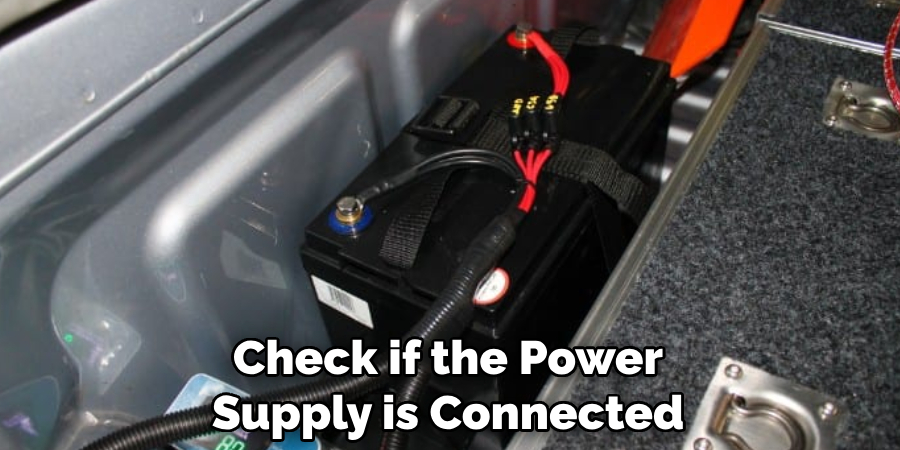
Conclusion
A car fridge is a fantastic investment for anyone who loves to travel, camp, or simply enjoy cold drinks and snacks on the go. By following these do’s and don’ts on how to run a car fridge, as well as the additional tips and precautions, you can ensure a smooth and convenient experience with your car fridge. Remember to always prioritize safety, proper care, and planning ahead when using a car fridge, and happy travels! So, with these tips in mind, you can confidently use and maintain your car fridge while on the road. Happy fridge-ing!
Finally, we hope this guide has been helpful in understanding how to properly run a car fridge and make the most out of its convenience and benefits. Cheers to many more adventures with a well-functioning car fridge by your side! So, with these tips in mind, you can confidently use and maintain your car fridge while on the road. Just remember always to prioritize safety and proper care for your car fridge to ensure its longevity and efficient operation.

